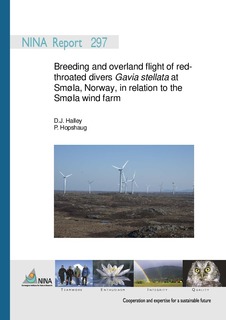| dc.description.abstract | Halley, D.J. & Hopshaug, P. 2007. Breeding and overland flight of red-throated divers Gavia stellata at Smøla, Norway, in relation to the Smøla wind farm. – NINA Report 297. 26 pp.
This report surveys the distribution and breeding success of red-throated divers Gavia stellata on the island of Smøla, Norway in the breeding seasons 1999-2004 inclusive, and 2007. Dur-ing this period, a large windfarm was constructed in the northwestern portion of the island in two stages. Stage 1, 20 2MW turbines, was constructed between September 2001 and Sep-tember 2002; stage 2, 48 2.3MW turbines, between October 2003 and October 2005. A total of twenty three breeding sites were found, up to twenty of which were used in any given year, though more typically 10-13 pairs would breed each year. Overall fledging success was 0.42 chicks/pair/year, similar to other coastal breeding populations. Whole-island breeding suc-cess in 2007, the first post-construction year for which we have data, was 0.15 chicks/pair; however, strong fluctuations in breeding success between years are normal in this species and it seems unlikely that the windfarm was a factor in this result as all breeding sites in 2007 were some distance away. Three red-throated diver breeding locations were noted within the windfarm area prior to con-struction, none of which have been used in years following construction of the stage in which each breeding site lies. It is unclear if this is due to the presence of the wind turbines in them-selves, increased disturbance due to easier human access to the area, and/or lingering effects of the extreme disturbance concomitant with construction. Although 46 hours and 20 minutes of structured observations were made within the windfarm area, and many more of unstructured observations by all scientists working in the windfarm area throughout the breeding season, not a single red-throated diver was observed to fly through the windfarm area, suggesting strong avoidance. At least four pairs breed in central areas of the island where the coast on the far side of the turbine arrays is, albeit by a small margin, the closest potential feeding habitat. The turbine arrays were checked regularly using a specially trained dog for birdstrike casual-ties. Although many such birds were found, mainly sea eagles Haliaeetus albicilla, grouse Lagopus lagopus, and waders, no red-throated diver corpses were recovered. Taken with the lack of observations of red-throated divers breeding in, or flying through, the windfarm area, this suggests that the risk of direct mortality from collisions at this location is very low. Further monitoring may include surveys early in the breeding season to determine if red-throated divers visit the wind farm area at that time, and so might resume breeding now that the construction phase and attendant disturbance is at an end; and focussed observations of the direction of feeding flights to and from the breeding sites on the central mire of the island, to determine whether these birds are simply preferring other feeding areas to those on the coast off the wind farm, or actively avoiding flight directions which would take them through the turbine arrays. Smøla; red-throated diver, Gavia stellata, windfarm, wind turbines, distribution, breeding, flight, population, Smøla, smålom, Gavia stellata, vindkraft, distribusjon, hekkebiologi, fluktadferd, bestand | nb_NO |
